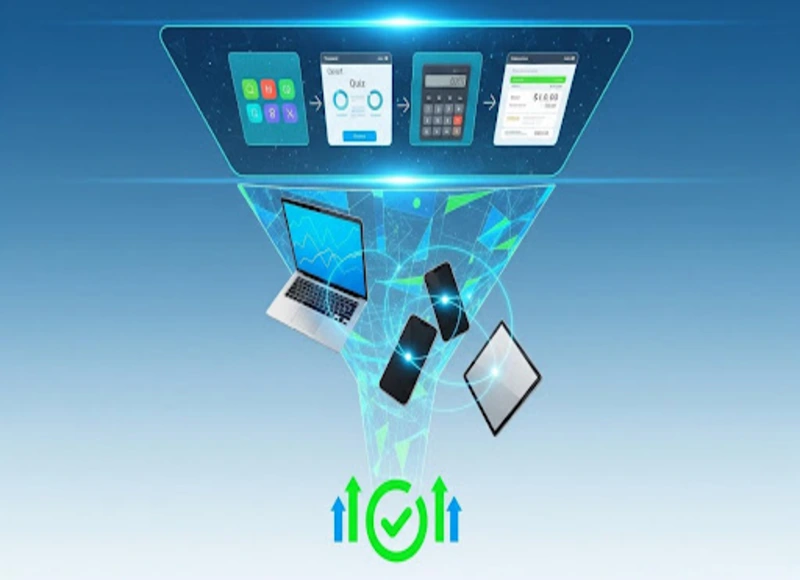Table of Contents
Find out more about eLearning platforms and the advantages and disadvantages of online learning. Gain insights for effective online learning strategies.

Today, eLearning integration supplements modern lecture education and anchors educational methodologies. Technology is advancing quickly. It makes eLearning a powerful force in changing how we learn. eLearning is significant in education, and many students even use tools like a reliable essay writing service to enhance their eLearning experience. People use it in everything from traditional classrooms to customized eLearning solutions. This article will discuss the complexity of eLearning.. This includes its platform, benefits, and drawbacks. We can better understand its future implications by examining how eLearning can improve learning.
Exploring the Role of eLearning in Education
Education systems have to adjust to meet the opportunities and difficulties of a world that is changing at a rapid pace. If you have academic challenges, you may get help from an urgent essay writing service which offers professional assignments and essay writing support. They help students who need extra help with their studies. This service with talented writers has become integral to the eLearning environment. It provides learners with all the resources necessary to succeed in their educational pursuits.
The quick change in educational frameworks has made eLearning systems important tools. They are replacing traditional knowledge acquisition methods, offering learners more flexible, scalable, and accessible learning environments, which can be further enhanced with robust educational platforms and learning management systems. Lets now investigate the several ways that eLearning is altering educational paradigms:
1. Flexible learning environments
Students may access instructional resources and materials whenever needed through eLearning. Students may take charge of their fast educational path. This flexibility accommodates various learning styles and timetables. For example, an eLearning platform like Mathful provides personalized step-by-step guides to help students solve math problems effectively.
2. Global Accessibility
Students can access education anywhere. eLearning breaks down obstacles based on location, allowing learners to engage with high-quality instructional materials without geographical or time limitations. For example, students preparing for certification exams can benefit from Microsoft AZ-400 Practice Tests, which provide structured guidance and targeted practice to help them succeed, regardless of where they are located.
3. Interactive Engagement
Interactive elements included in eLearning platforms increase students' participation and engagement. These resources range from virtual simulations to multimedia AI presentations. They encourage active learning experiences. This deepens comprehension and helps students remember concepts. Among the myriad educational technologies, you will find some unique and engaging matching games that stands out for their immersive capability to cater especially to young learners. Perfecting not just subject knowledge but also critical thinking and memory skills, these platforms represent a unique aspect of eLearning, seamlessly blending education with entertainment.
4. Cost-effectiveness
eLearning turns out to be more cost-effective than conventional classroom-based learning. Educational institutions and students can cut costs. They can do this by utilizing one of the many free or priced eLearning systems. This will save them money on textbooks, commuting, and facility maintenance.
5. Scalability
Scalability is the advantage provided by eLearning platforms. They can handle many learners at the same time. Because of its scalability, eLearning is suitable for small groups in the classroom. It is also suitable for massive open online courses (MOOCs).
In essence, eLearning in higher education is a paradigm shift. It envelops learners with the freedom of learning. This includes flexibility, accessibility, and an interactive learning environment. Using eLearning allows educators to unlock the transformational power of 21st-century education. It promotes a dynamic, inclusive, student-centered learning environment. This prepares learners for future challenges and possibilities.
Best eLearning platforms: List of top choices for educational improvement
The eLearning world is growing. Various platforms provide different features and resources to improve learning. Here are some of the top choices for educational enhancement:
1. Udemy
a. It is famous due to its wide array of topics. Professionals or specialists in the relevant field give lectures.
b. The courses provide lifelong accessibility. This enables learners to return to them in their own time.
c. Permits educators to write and sell their courses, enriching access to educational materials, including Microsoft AZ-500: Practice Tests Dumps to help learners prepare effectively.
2. Khan Academy
a. It offers high-quality and free education to anyone, anywhere. They also have courses in many disciplines, ranging from math to history.
b. Provides interactive practice exercises, instructional videos, and individualized learning dashboards for learners.
3. LinkedIn Learning
a. Provides professional development and offers courses focused on business, technology, and creative skills.
b. Learners can integrate created courses and received certificates into their LinkedIn profiles. Then, they can show them to recruiters.
4. Google Classroom
a. It enables the interaction and cooperation between instructors and students. They can do this through assignments, feedback, and announcements.
b. It manages online classes for educators. This makes it easier to distribute and organise course materials.
These top eLearning platforms align with learners' requirements. They offer attractive and convenient learning modes for personal or professional growth. These options are available through popular platforms.
ELearning in education programs: Its advantages and disadvantages
Education has been changing in the digital era. eLearning programs have become the means of transformation. They offer learners worldwide countless possibilities for flexibility and accessibility. But despite many benefits, eLearning platforms also have several drawbacks and limitations.
Advantages
- Flexibility
Elearning programs offer flexibility. Students can access materials and lectures at a time convenient to them. This feature is particularly favourable for non-traditional students. It's also great for working professionals and individuals with busy schedules.
- Accessibility
eLearning wipes away geographical barriers. All students worldwide can access academic resources from anywhere. They just need an internet connection. Moreover, this allows everybody to access quality education.
- Cost-effectiveness
eLearning tends to be cheaper than traditional classroom-based training. It minimises travel, stocking various textbooks, and sometimes tuition fees. It also makes education affordable to a more extensive range of learners.
- Updated content
Updating content is easier online, so eLearning platforms enable the students to access the most timely and relevant information. Course materials can be revised quickly.
- Self-paced learning
Students can learn at their own pace and revisit material as often as needed on an eLearning platform. This caters better to the different learning styles.
- Interactivity
eLearning platforms allow for interactive content like simulations, polls, and quizzes. They also have discussion boards and video conferencing. This increases student engagement and knowledge retention.
Disadvantages
- Dependence on technology
The majority of eLearning programs are technology-based. This may act as a disadvantage to some learners. They may have poor internet access. This could be due to technical glitches, software limitations, or system failures.
- Lack of face-to-face interaction
One disadvantage of eLearning is the lack of direct contact between the instructors and learners. This absence of contact may impede the progress of the student's social and communication skills. It also makes it harder for them to ask questions and get instant responses.
- Potential for distractions
When studying online, distractions might occur. These could be from emails, social media, and other online activities. Lack of an organised setting and teacher supervision may make it hard for students to remain focused and motivated.
- Less accountability
If instructors don't check progress, students may skip assignments. They may fall behind or plateau in online self-paced courses. Procrastination can be a huge issue.
- Technology barriers
Some students may lack access to reliable internet/devices required for eLearning, creating equity issues. There can also be a steep learning curve when using the new platforms/tools.
Acknowledge and overcome the pros and cons of eLearning in education programs. This way, you can enjoy its full capacity and develop the future shape of education.
Wrapping up
In conclusion, eLearning within education unveils its impact on contemporary learning models. eLearning platforms offer flexibility, accessibility, and scalability. But they have their own set of challenges. These include the dependency on technology and the possibility of getting distracted. Educators are also likely to take complete advantage of eLearning tools. The designers of these tools aim to revolutionise education for students in many settings. Amidst the changing technology, the answer is clear: strategic use of eLearning will prepare us for an unimaginable future. In the future, education will be more accessible, meaningful, and potent.
Recent Blogs
Key Benefits of Hiring Nearshore React.js Development Teams for Enterprise Projects
-
20 Jan 2026
-
10 Min
-
109
Stop Building from Scratch: Boost Your Marketing Funnel with App Templates
-
13 Jan 2026
-
10 Min
-
462







